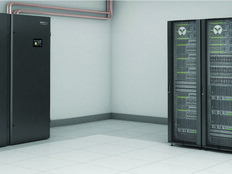Feds Report Faster Deployments with Unified Computing
Unified computing platforms at NASA’s Marshall Space Flight Center in Huntsville, Ala., let the IT department improve performance by running servers, network switches and storage on one backplane.
Randy Sparkman, manager of infrastructure and operations for the Marshall Space Flight Center, says it previously would have taken the IT staff 14 to 20 weeks to install new infrastructure. Now, that job can be done in less than six weeks. “We get a faster turnaround, and it takes much less labor to roll out a new computing environment,” Sparkman says.
Marshall Space Flight Center deployed the VCE Vblock System which combines VMware virtualization, Cisco Systems’ Unified Computing System servers and switches, and EMC storage.
NASA Marshall uses the Vblock system to run agencywide financial, procurement, budget and numerous other line-of-business applications; administrative and high-performance computing applications in the Huntsville complex; and a disaster recovery site at Kennedy Space Center in Florida.
Data Center Services Manager Keaven Moreau says that in the three years since deploying Vblock, NASA has increased its computing infrastructure by 40 percent — and accomplished that with 20 percent fewer resources. “Basically, we rolled out more OS instances with the same number of people,” he says.
Sparkman says the agency runs more efficiently because it can virtualize most of the new computing environment, thus reducing the need for systems administrators to roll out dozens more servers, switches and storage devices.
He adds that budgets are more predictable now, too, because the three computing platforms are budgeted over a three-to-five-year refresh cycle. “Before, we would buy new systems as requirements emerged,” Sparkman explains. “Now, we try to stay ahead of the requirements and can purchase infrastructure as a single system.”
Mark Bowker, a senior analyst for the Enterprise Strategy Group, says NASA’s deployment of what the ESG calls an integrated computing platform makes sense. “It gives them the ability to roll out applications much faster and not worry about the infrastructure,” Bowker says. “They also have one number to call for service, and these integrated consortiums can get parts out faster.”
Another Take
The Census Bureau did not deploy a prepackaged data center environment like NASA’s, but it did implement an integrated environment using hardware and software from five primary vendors: BMC, Cisco, HP, IBM and VMware.
36%
The percentage of 2013 IT budgets allocated to new technology projects and purchases that deliver positive ROI and competitive advantage to the organization
SOURCE: “Market Landscape Reports: Integrated Computing Platforms” (Enterprise Strategy Group, June 2013)
“We chose to standardize and integrate these vendor products primarily to drive down IT costs, while improving our customer responsiveness and satisfaction,” says Harry A. Lee, the agency’s senior computer scientist for infrastructure. “We also wanted to build an integrated computing platform with the necessary government and contractor resources to support the development and delivery of enterprise shared IT services.”
Lee says some of the shared IT services Census has rolled out include VDI, enterprise communications and collaboration, enterprise portfolio, and project management and integrated high-performance computing.
By rolling out these services, Lee says, the agency has:
- Reduced hardware, software and support services costs by 25 percent
- Reduced the number of storage vendors from nine to one by deploying a storage area network
- Reduced the number of server vendors from 10 to 1
- Virtualized 80 percent of the agency’s servers
- Increased storage utilization by 50 percent
- Reduced backup and recovery costs by 50 percent by implementing an enterprise and data backup and restoration service and support contracts
- Reduced the time required to provision computing and storage resources by 60 percent through improved automation








